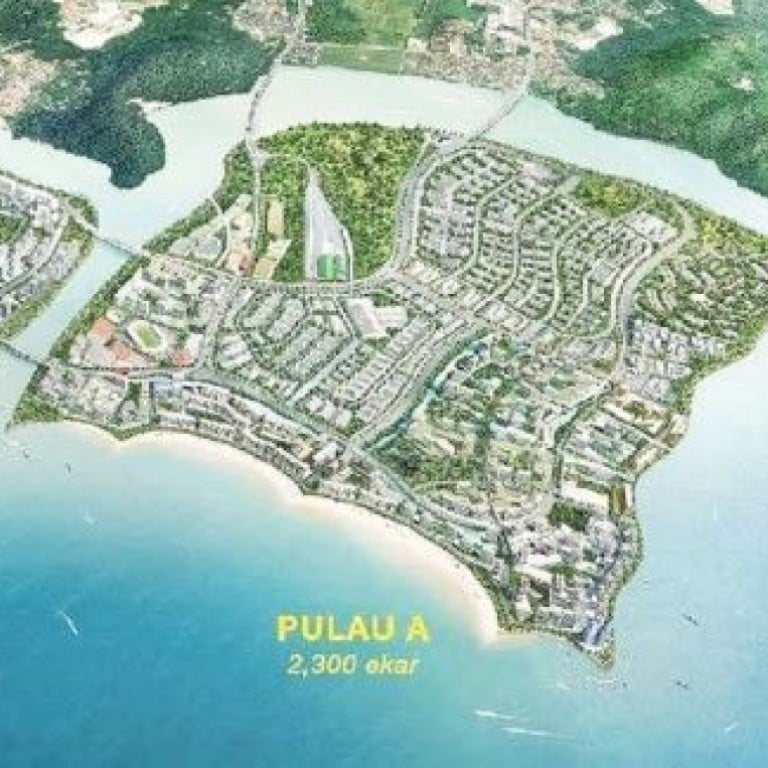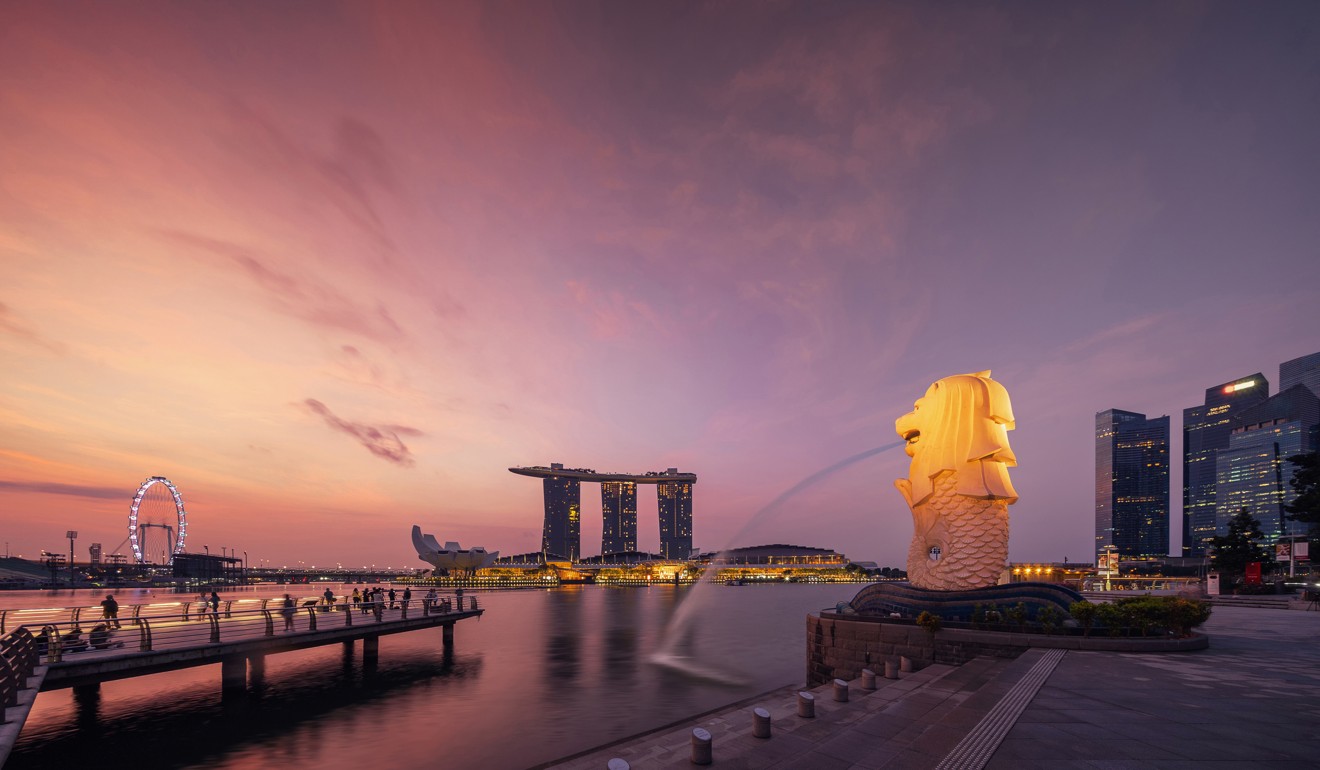
Penang wants to be like Hong Kong and Singapore. Problem: its fishermen don’t
- Malaysian state planning three-island land reclamation project that will rival Singapore’s Marina Bay and help fund US$11 billion overhaul of transport system
- But on the environment, are Singapore and Hong Kong really such good examples to follow?
Local fishermen have joined a growing number of civil and environmental activists opposed to a plan to ease congestion on the island and provide better links to the mainland side of Penang state, all funded by a three-island land reclamation project said to rival Singapore’s Marina Bay.
“It’s going to be a disaster if the state does not think this through,” said Nazri Ahmad, chairman of Persatuan Nelayan Pulau Pinang, the state’s fishermen association. Nazri warned the environmental impact of the reclamation project would decimate fish breeding grounds and hurt the livelihoods of the state’s fishermen and their crew – numbering about 6,000 people in all.
The Penang South Reclamation project was proposed to fund the 46 billion ringgit (US$11.2 billion) Penang Transport Master Plan (PTMP), which is aimed at shortening commuting times and attracting more foreign investment in the state of 1.7 million people.

It includes a light rail transit line, an elevated highway that cuts through two public parks and tunnels through hills, a monorail and an undersea tunnel that will link Penang island to the mainland – providing an additional link to the two bridges that already exist.
The reclamation is part of a proposed deal with the project delivery partner of the PTMP, SRS Consortium, which is a joint venture between Gamuda Berhad, one of Malaysia’s largest infrastructure developers and two Penang developers.
The state government has said it will take out a bridging loan to pay for the reclamation. It then plans to sell the islands or development rights to them to pay off the loan and fund the infrastructure projects.
Singapore seeks to extend truce with Malaysia over air and sea borders
The company will create three islands totalling 1,800 hectares, the same size as the controversial Forest City development in the southern Johor state.
“The state government wanted the three islands because they said there is no more land on the island, but it forgets there is land in Seberang Prai that desperately needs investment and infrastructure,” said Khoo Salma Nasution, vice-president of the Penang Heritage Trust and a former city councillor, referring to the part of the state on the Malay Peninsula.
Nazri said the state had yet to directly meet the fishermen to discuss the plan. “But any reclamation is going to impact the ecosystem, maybe not immediately, but in 10 to 15 years there will be no more fish,” he said.
“It has already happened with other reclamation projects [in the north] of Penang; mackerels, blue crabs and ikan sembilang [a type of catfish] are declining.”
The fishermen have been granted a closed-door meeting with the state’s chief minister Chow Kon Yeow on April 22 where they will demand the state review the plan, but Nazri fears it may not amount to much.

Despite other mega projects across Malaysia such as the China-funded East Coast Rail Link coming under review after the Pakatan Harapan government came to power last May, Chow has said he hopes the plan will be given the go-ahead by the federal government by June.
Construction would then start on the first phase, which includes the elevated highway and light rail transit system, at the same time as the land reclamation project.
Mahathir’s Malaysia still ‘open for business’ with China despite stalled projects
“This is a very risky model because of the timing difference of cash flow. What is going to happen when nobody wants to buy the units on the reclaimed land?” asked Lim Mah Hui, a former city councillor and banking expert with Penang Forum, a group made up of various local NGOs.

Chow has largely ignored opposition to the plan, even calling for the fishermen to “understand the importance of the reclamation project”. He declined an interview with the South China Morning Post.
LIFE ON THE HIGHWAY
Financing woes aside, other aspects of the PTMP have also been called into question, particularly the elevated highway, dubbed the pan-island link.
Proponents of the PTMP defend the state’s decision to spend nearly 40 times its annual budget to build, among other things, more highways in a state where people face long commutes due to traffic congestion. Penang has the fifth largest GDP of Malaysia’s states, mainly due to an industrial free zone in the south of the island. But its economy has slowed in recent years and the state is now largely a tourist attraction, best known for its street food and Unesco World Heritage Site George Town.
Timothy Tye, a spokesperson for Anak Pinang, an NGO that supports the PTMP, says the highway is desperately needed for those living in rural areas further from George Town who deal with long commutes daily.
“They need something that will help improve the quality of their lives, particularly to help them get home earlier,” said Tye. The pan-island link would alleviate congestion by diverting traffic from the residential areas on the island’s north coast towards the south, away from the already overloaded main thoroughfares, Tye said.

The highway, when combined with the undersea tunnel and light rail transit system and feeder buses, would make things easier for commuters across the state, said Tye.
However, critics say people living along the path of the proposed highway have not been consulted and many do not realise the disruption the highway might cause.
“Parts of the highway will be just five metres from people’s houses, and it will cut through two parks, one of which has the cleanest river in Malaysia,” said Khoo.
Other parts of the highway will tunnel into Penang island’s hills, another sore point for the state, particularly after a deadly landslide at a hillside road construction site killed nine foreign workers last October. Since then, calls for an in-depth review have intensified.
What Malaysia’s Mahathir really plans for China-backed projects
Yet Chow has accused critics of holding up the state’s development, using Hong Kong as an example of hillside development and saying if Hong Kong had taken the advice of NGOs in Penang, the city would not have developed to where it was today.
However, city planning and urban design researcher Louie Sieh said this was too simple a comparison.
“Hong Kong is highly helped by its geography, so it wouldn’t be as easy for a different city with a different geography to develop this way,” said Sieh, an assistant professor at City University of Hong Kong.

The proportion of slopes to flat land in Hong Kong is much higher than in Penang, said Alain Chiaradia, the director of the University of Hong Kong’s Urban Design programme.
According to a set of hillside development safety guidelines released by the Penang state government, only 40 per cent of slopes on Penang island are steeper than 25 degrees. In Hong Kong, 75 per cent of the land is made up of slopes steeper than 30 degrees.
Why are so many Penangites settling in Hong Kong?
“So do you really need to build on the slopes in Penang?” asked Alain.
PROBING QUESTIONS
Meanwhile, Malaysia’s finance minister and former Penang chief minister Lim Guan Eng, who was in office when the PTMP was proposed, has also come under fire from the former prime minister Najib Razak, who claims the undersea tunnel project was not awarded to a developer through an open tender process.

The Malaysian Anti-Corruption Commission launched six probes into the project between July 2017 and January last year after one of the developers involved was accused of bribing the state government. Two of the investigations have been turned over to the attorney general.
While environmental impact assessments for all of the construction projects including the pan-island link and reclamation project are yet to be approved by the Malaysian Department of Environment, Khoo, Nazri and Lim said it was likely the projects would be approved.
“The fisheries [and environment departments] probably don’t like the projects, but if the government wants it done, they will follow, there’s nothing they can do,” said Nazri.
“The government really needs to think about the stakeholders here, and think about how to save the fishing industry,” Nazri said, lamenting the fate of the surrounding ocean. “When it comes to the sea, the fishermen will be hurt if it is destroyed.” ■
This story has been corrected as an earlier version said the proposed deal between the government and SRS Consortium was a land swap. Clarifications have also been made to the number of fishermen and crew, and to make clear that the amount spent on the masterplan is meant for different types of infrastructure, including highways.


